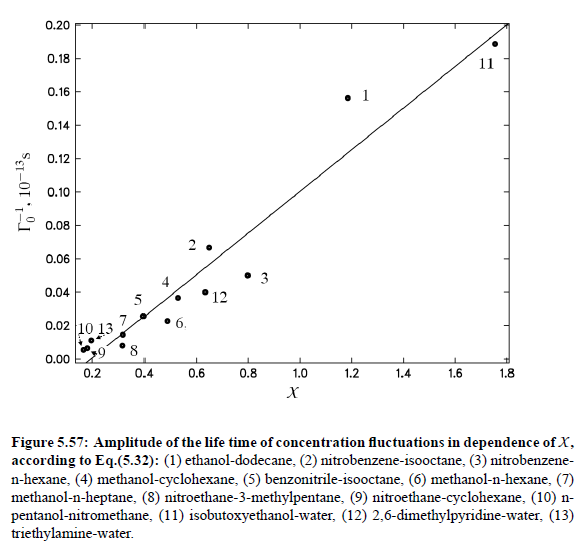2018-(II)-Surface Tension in Critical Mixtures
Article Index
Finally, we have an additional indication for correlations between surface tension and mutual diffusion coefficient, and consequently between mutual diffusion and the fluctuations correlation time. However, it has long been known from experiment that ∂σ/∂x = 0 (x denotes composition) at the critical poin in binary mixtures. Theory predicts more specifically that, as the critical point is approached, the surface tension σ as function of reduced temperature ε, vanishes according to power law with an critical exponent µ:
The critical exponent µ, is related to the correlation length exponent ν, by the Widom scaling law:
in which d is the spacial dimension of the system. Unfortunately, it is not possible to find for all considered systems experimental literature data of σ, probably, due to experimental problems in the determination of this quantity:
here A , B denote the components and x the mole fraction (x = x_c) at critical composition. Surface tension data for pure liquids of all components of binary mixtures presented in Table (5.10) have been found in the literature [Dewan R. K., Mehta S. K.; Chemical Monthly Springer (1990) B28 (1935) 119], where for every component the surface tension of four temperatures is listed. Values at temperatures between the tabulated ones could be obtained by linear interpolation with an error of less than ±0.02 mN/m. Taken into account the critical temperature of a mixtures as well as using the last equation the surface tension σ_id has been calculated, Table (5.10):
In order to perform qualitative studies of a correlation between characteristic relaxation rate and the surface tension, both quantities have been plotted against another in Fig.(5.56). Unfortunately, the data points do not represent any analytical behavior. Nevertheless, the plot displays three groups of binary critical systems. Group (I) represents binary mixtures, where the characteristic relaxation rate decreases with increasing surface tension, while group (II) displays an opposite trend. The third group (III) shows the behavior of binary aqueous solutions, with by far the largest surface tension. However, this kind of qualitative studies give an indication that there must exists an additional parameter which interacts additionally with the surface tension. In fact it has been argued by Fisk and Widom and recognized later as an aspect of the tow-scale factor universality that there exists a universal combination of critical amplitudes involving the surface tension amplitude σ_0, [Fisk S., Widom B.; J. Chem. Phys. 50 (1969) 3219]. According to Brezin [Brezin E., Shechao F.; Phys. Rev. B 29 (1984) 472], the simplest way to define the universal combination is to notice that the free interfacial energy per unit area (divided by k_CB T_c), multiplied by an area as defined by the correlation length, is both temperature independent and universal in the vicinity of T_c. Owing to this argument, the following expression can be written:
where X = 1/4 ·πk and k is a dimensionless quantity between 1.39 and 1.57 from theory, kB , is Boltzmann’s constant and ε is the reduced temperature. However, it was also reported in [Brezin E., Shechao F.; Phys. Rev. B 29 (1984) 472], that k lies in the interesting range between 0.5 and 2.00. The last equation plays a key role in understanding the nature of critical wetting and it is likewise a powerful expression, which connects the surface tension and fluctuation correlation length. However, using the same surface tension values, calculated with the aid of:
the dependence of the characteristic relaxation rate Γ_0 , and accordingly the life time of fluctuations could be studied as a function of the correlation length as well as surface tension. In fact the qualitative plot of life time of fluctuations Γ_0^−1 demonstrates a linear dependence on quantity X Fig.(5.57). Once more it should be underlined, that this are only qualitative studies.
- << Prev
- Next






